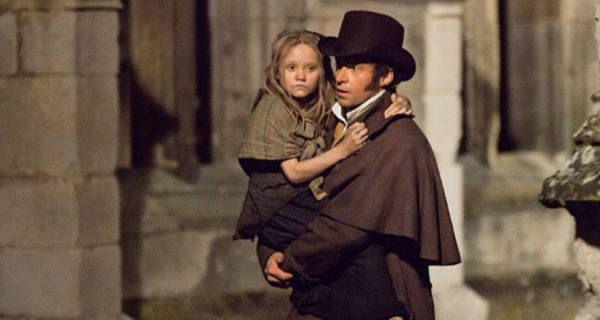I have fond memories of seeing Les Miserables in its San Francisco stage production many years ago. It was therefore with great disappointment—and with some questioning of my judgment in earlier years—that several months ago I saw the 25th anniversary stage production (a cynical affair, I thought), and with correspondingly heightened delight that I recently watched (and re-watched) the recent film adaptation with Hugh Jackman, Russell Crowe, Anne Hathaway, et al.
I was particularly struck by two aspects of the film: first, the unexpectedly sympathetic portrayal of religious imagery, and second, the immense charity and understanding with which the characters were presented. (To be sure, the film also contains powerful renditions of the classic Les Miserables songs, plus a great deal of haunting imagery, such as the symbolic scenes of Inspector Javert beneath the stars far above the sleeping city of Paris, walking a ledge with measured step. But such “natural beauty” was less startling and unexpected than the “moral beauty”, which is of central importance.)
The religious dimension is portrayed in a way that, although sometimes subtle, sometimes more overt, is profoundly sympathetic and very beautiful. Valjean’s new life begins when a bishop with great compassion and humility “buys his soul for God” at the price of his silver candlesticks. Unlike in any modern production that I can recall, the bishop is portrayed as being thorougly genuine and loving, and is the one who first welcomes Valjean into heaven after his death. Valjean and Cosette also take refuge in a monastery midway through the film, and Valjean again returns to the monastery, as to a refuge, when he is dying. I failed to notice until late in the film—more astute viewers may have noticed it far earlier than I—that even in the greatest haste, Valjean carefully packs his candlesticks—the price of his soul—each time that he flees the relentless Javert from one location to set up a new life in another.
I was also amazed to see how omnipresent imagery of crosses and crucifixes was throughout the film, not only prominently on the dressers of Valjean and Javert, but also subtly, in unexpected places, such as on the barricade where the student revolutionaries stage their uprising. (As if Emmanuel, “God with us”, is secretly, silently, accompanying them all, pure or flawed, in all places and all circumstances.)
I was also struck by the great charity–compassion and understanding–with which the characters were portrayed. Most productions would use the conflict to set up characters who are the enemy, who are portrayed as without redeeming virtues, people that the audience can hate. Yet aside from a few malevolent minor characters who torment Fantine, shown only for a few moments, only the Thernardiers are portrayed as out-and-out villians, and that‘s only fitting, given their role as a sort of comic relief.
Javert’s blind, misguided commitment to stern justice and order is portrayed with compassion, as a kind of tragedy. Both the student revolutionaries, who go out foolishly but boldly to resist the government, and the young officer who leads the soldiers opposed to them (and whose discomfort with the prospect of initiating a one-sided battle that will lead to their slaughter shows on his face when he orders the attack)… both Marius, the aristocratic young revolutionary who disclaims his class, and his wealthy grandfather who is wounded by his actions but who continues to love him nonetheless… all are portrayed with understanding and love.
There are few works—and in particular major films—that I can recall that are of this nature, that don’t fall back from time to time on the device of opposing love for one group with loathing for their enemies. (The novels of the little-known but gloriously compassionate author Elizabeth Goudge is one of the exceptions that comes to mind.) These are the sort of eyes that I imagine holy-hearted people have when they look upon the world and its creatures–whether noble and generous, or erring and lost–with compassion and love.
My sole disappointment came in the final minutes, when Valjean passes through death, welcomed by the priest in the darkness of the church and led out by Fantine into the sunshine, to the vision of a new society. As if one had passed through the veil of the transcendent, hinted at by all that preceded it, to arrive… in Paris again? Only this time with singing, happy people? (I suppose that in theory it could be like the real Narnia, after the old world has passed away… but it wasn’t.) A new, more humane, more just, more jubilant society—nice though it is—is quite a letdown, if one was hoping for the Beatific Vision, and this final scene ever-so-slightly undermines the greatness that preceded it and leaves one speculating about the director’s intentions in including it. But then one can just sigh gently, put aside the apparent imperfection of this final part, and dwell again within the beauty of the whole.


Yeah – I love Les Mis too and it always moves me to tears. Though your comments at the end made me smile – are you saying Paris isn’t heaven? 😉
Love this movie. not a musical fan but this movie was simply spectacular. And while I understand the point about the ending, I take a slightly more optimistic approach.